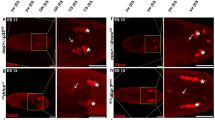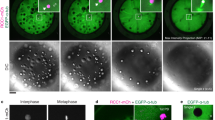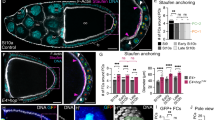Abstract
The primordial germ cells (PGCs) are the first cells to form during Drosophila melanogaster embryogenesis. Whereas the process of somatic cell formation has been studied in detail, the mechanics of PGC formation are poorly understood. Here, using four-dimensional multi-photon imaging combined with genetic and pharmacological manipulations, we find that PGC formation requires an anaphase spindle-independent cleavage pathway. In addition to using core regulators of cleavage, including the small GTPase RhoA (Drosophila rho1) and the Rho-associated kinase, ROCK (Drosophila drok), we show that this pathway requires Germ cell-less (GCL), a conserved BTB-domain protein not previously implicated in cleavage mechanics. This alternative form of cell formation suggests that organisms have evolved multiple molecular strategies for regulating the cytoskeleton during cleavage.
This is a preview of subscription content, access via your institution
Access options
Subscribe to this journal
Receive 12 print issues and online access
$209.00 per year
only $17.42 per issue
Buy this article
- Purchase on Springer Link
- Instant access to full article PDF
Prices may be subject to local taxes which are calculated during checkout





Similar content being viewed by others
References
Sullivan, W. & Theurkauf, W. E. The cytoskeleton and morphogenesis of the early Drosophila embryo. Curr. Opin. Cell Biol. 7, 18–22 (1995).
Glover, D. M. Mitosis in the Drosophila embryo–in and out of control. Trends Genet. 7, 125–132 (1991).
Edgar, B. A., Kiehle, C. P. & Schubiger, G. Cell cycle control by the nucleo-cytoplasmic ratio in early Drosophila development. Cell 44, 365–372 (1986).
Foe, V. E., Field, C. M. & Odell, G. M. Microtubules and mitotic cycle phase modulate spatiotemporal distributions of F-actin and myosin II in Drosophila syncytial blastoderm embryos. Development 127, 1767–1787 (2000).
Karr, T. L. & Alberts, B. M. Organization of the cytoskeleton in early Drosophila embryos. J. Cell Biol. 102, 1494–1509 (1986).
Wieschaus, E. & Sweeton, D. Requirements for X-linked zygotic gene activity during cellularization of early Drosophila embryos. Development 104, 483–493 (1988).
Simpson, L. & Wieschaus, E. Zygotic activity of the nullo-locus is required to stabilize the actin myosin network during cellularization in Drosophila. Development 110, 851–863 (1990).
Schejter, E. D. & Wieschaus, E. Bottleneck acts as a regulator of the microfilament network governing cellularization of the Drosophila embryo. Cell 75, 373–385 (1993).
Lecuit, T. & Wieschaus, E. Polarized insertion of new membrane from a cytoplasmic reservoir during cleavage of the Drosophila embryo. J. Cell Biol. 150, 849–860 (2000).
Lecuit, T., Samanta, R. & Wieschaus, E. Slam encodes a developmental regulator of polarized membrane growth during cleavage of the Drosophila embryo. Dev. Cell 2, 425–436 (2002).
Thomas, J. H. & Wieschaus, E. src64 and tec29 are required for microfilament contraction during Drosophila cellularization. Development 131, 863–871 (2004).
Stein, J. A., Broihier, H. T., Moore, L. A. & Lehmann, R. Slow as molasses is required for polarized membrane growth and germ cell migration in Drosophila. Development 129, 3925–3934 (2002).
Ephrussi, A. & Lehmann, R. Induction of germ cell formation by oskar. Nature 358, 387–392 (1992).
Mahowald, A. Assembly of the Drosophila germ plasm. Int. Rev. Cytol. 203, 187–213 (2001).
Green, R. A., Paluch, E. & Oegema, K. Cytokinesis in animal cells. Annu. Rev. Cell Dev. Biol. 28, 29–58 (2012).
Field, C. M., Coughlin, M., Doberstein, S., Marty, T. & Sullivan, W. Characterization of anillin mutants reveals essential roles in septin localization and plasma membrane integrity. Development 132, 2849–2860 (2005).
Castrillon, D. H. & Wasserman, S. A. Diaphanous is required for cytokinesis in Drosophila and shares domains of similarity with the products of the limb deformity gene. Development 120, 3367–3377 (1994).
Afshar, K., Stuart, B. & Wasserman, S. A. Functional analysis of the Drosophila diaphanous FH protein in early embryonic development. Development 127, 1887–1897 (2000).
Jongens, T. A., Hay, B., Jan, L. Y. & Jan, Y. N. The germ cell-less gene product: a posteriorly localized component necessary for germ cell development in Drosophila. Cell 70, 569–584 (1992).
Warn, R. M., Smith, L. & Warn, A. Three distinct distributions of F-actin occur during the divisions of polar surface caps to produce pole cells in Drosophila embryos. J. Cell Biol. 100, 1010–1015 (1985).
Karess, R. E. et al. The regulatory light chain of nonmuscle myosin is encoded by spaghetti-squash, a gene required for cytokinesis in Drosophila. Cell 65, 1177–1189 (1991).
Field, C. M. & Alberts, B. M. Anillin, a contractile ring protein that cycles from the nucleus to the cell cortex. J. Cell Biol. 131, 165–178 (1995).
Hickson, G. R. X. & O’Farrell, P. H. Anillin: a pivotal organizer of the cytokinetic machinery. Biochem. Soc. Trans. 36, 439–441 (2008).
Glotzer, M. The molecular requirements for cytokinesis. Science 307, 1735–1739 (2005).
Hickson, G. R. X. & O’Farrell, P. H. Rho-dependent control of anillin behavior during cytokinesis. J. Cell Biol. 180, 285–294 (2008).
Aktories, K., Braun, U., Rosener, S., Just, I. & Hall, A. The rho gene product expressed in E. coli is a substrate of botulinum ADP-ribosyltransferase C3. Biochem. Biophys. Res. Commun. 158, 209–213 (1989).
Narumiya, S., Sekine, A. & Fujiwara, M. Substrate for botulinum ADP-ribosyltransferase, Gb, has an amino acid sequence homologous to a putative rho gene product. J. Biol. Chem. 263, 17255–17257 (1988).
Amano, M. et al. Phosphorylation and activation of myosin by Rho-associated kinase (Rho-kinase). J. Biol. Chem. 271, 20246–20249 (1996).
Winter, C. G. et al. Drosophila Rho-associated kinase (Drok) links Frizzled-mediated planar cell polarity signaling to the actin cytoskeleton. Cell 105, 81–91 (2001).
Narumiya, S., Ishizaki, T. & Uehata, M. Use and properties of ROCK-specific inhibitor Y-27632. Methods Enzymol. 325, 273–284 (2000).
Royou, A., Sullivan, W. & Karess, R. Cortical recruitment of nonmuscle myosin II in early syncytial Drosophila embryos: its role in nuclear axial expansion and its regulation by Cdc2 activity. J. Cell Biol. 158, 127–137 (2002).
Yuce, O., Piekny, A. & Glotzer, M. An ECT2-centralspindlin complex regulates the localization and function of RhoA. J. Cell Biol. 170, 571–582 (2005).
Su, K. C., Takaki, T. & Petronczki, M. Targeting of the RhoGEF Ect2 to the equatorial membrane controls cleavage furrow formation during cytokinesis. Dev. Cell 21, 1104–1115 (2011).
Leatherman, J. L., Levin, L., Boero, J. & Jongens, T. A. germ cell-less acts to repress transcription during the establishment of the Drosophila germ cell lineage. Curr. Biol. 12, 1681–1685 (2002).
Jongens, T. A., Ackerman, L. D., Swedlow, J. R., Jan, L. Y. & Jan, Y. N. Germ cell-less encodes a cell type-specific nuclear pore-associated protein and functions early in the germ-cell specification pathway of Drosophila. Gene. Dev. 8, 2123–2136 (1994).
Lehner, C. F. The pebble gene is required for cytokinesis in Drosophila. J. Cell Sci. 103, 1021–1030 (1992).
Civelekoglu-Scholey, G. & Scholey, J. M. Mitotic force generators and chromosome segregation. Cell. Mol. Life Sci. 67, 2231–2250 (2010).
Cabernard, C., Prehoda, K. E. & Doe, C. Q. A spindle-independent cleavage furrow positioning pathway. Nature 467, 91–94 (2010).
Hejnol, A. & Pfannenstiel, H. D. Myosin and actin are necessary for polar lobe formation and resorption in Ilyanassa obsoleta embryos. Dev. Genet. Evol. 208, 229–233 (1998).
Conrad, G. W., Schantz, A. R. & Patron, R. R. Mechanisms of polarlobe formation in fertilized eggs of molluscs. Ann. NY Acad. Sci. 582, 273–294 (1990).
De la Luna, S., Allen, K. E., Mason, S. L. & La Thangue, N. B. Integration of a growth-suppressing BTB/POZ domain protein with the DP component of the E2F transcription factor. EMBO J. 18, 212–228 (1999).
Leatherman, J. L., Kaestner, K. H. & Jongens, T. A. Identification of a mouse germ cell-less homologue with conserved activity in Drosophila. Mech. Dev. 92, 145–153 (2000).
Kimura, T. et al. Mouse germ cell-less as an essential component for nuclear integrity. Mol. Cell. Biol. 23, 1304–1315 (2003).
Kleiman, S. E. et al. Reduced human germ cell-less (HGCL) expression in azoospermic men with severe germinal cell impairment. J. Androl. 24, 670–675 (2003).
Silverman-Gavrila, R., Hales, K. & Wilde, A. Anillin-mediated targeting of peanut to pseudocleavage furrows is regulated by the GTPase ran. Mol. Biol. Cell 19, 3735–3744 (2008).
Sano, H., Nakamura, A. & Kobayashi, S. Identification of a transcriptional regulatory region for germline-specific expression of vasa gene in Drosophila melanogaster. Mech. Dev. 112, 129–139 (2002).
Van Doren, M., Williamson, A. L. & Lehmann, R. Regulation of zygotic gene expression in Drosophila primordial germ cells. Curr. Biol. 8, 243–246 (1998).
Schubiger, G. & Edgar, B. Using inhibitors to study embryogenesis. Methods Cell. Biol. 44, 697–713 (1994).
Theurkauf, W. E. Immunofluorescence analysis of the cytoskeleton during oogenesis and early embryogenesis. Methods Cell. Biol. 44, 489–505 (1994).
Rothwell, W. F. & Sullivan, W. Fixation of Drosophila embryos. CSH Protoc.http://dx.doi.org/10.1101/pdb.prot4827 (2007).
Acknowledgements
We thank all members of the Lehmann laboratory for discussions and reagents. We thank A. Blum, S. Burden, T. Hurd, M. Slaidina, F. Teixeira and A. Zamparini for critical reading of the manuscript. We also thank S. Burden, H. Knaut, J. Nance, G. Schubiger, S. Small, J. Treisman and E. Wieschaus for discussions during the course of this work. We thank the Drosophila Bloomington Stock Center, T. Jongens, C. Fields, H. Sano, and A. Wilde for reagents. This work was supported by a NSF Predoctoral Fellowship to R.M.C. R.L. is a Howard Hughes Medical Institute Investigator. We dedicate this manuscript to the memory of G. Schubiger whose work in the early Drosophila embryo largely inspired the experiments presented here.
Author information
Authors and Affiliations
Contributions
R.M.C and R.L. conceived the project. R.M.C carried out the experiments and analysed the data. R.M.C and R.L. wrote the paper.
Corresponding author
Ethics declarations
Competing interests
The authors declare no competing financial interests.
Supplementary information
Supplementary Information
Supplementary Information (PDF 441 kb)
PGC formation in an embryo expressing Anillin–GFP.
This video shows four paired furrows forming and then constricting. (MOV 158 kb)
Paired furrow constriction in a Myosin–GFP and Vasa-KO embryo.
This video shows a single paired furrow constricting. Myosin–GFP (green) and Vasa-KO (red). (MOV 69 kb)
Anillin–GFP expression at the BF following DMSO injection.
DMSO injection does not disrupt the localization of Anillin at the BF. (MOV 20 kb)
Anillin–GFP expression at the BF following C3 peptide injection.
C3 peptide injection does disrupt the localization of Anillin at the BF. (MOV 31 kb)
BF constriction following colcemid injection in an embryo expressing Anillin–GFP.
Note that although the BF constricts, the AF does not form. (MOV 54 kb)
PGC formation in a gcl mutant; embryo expressing Anillin–GFP.
This video shows that the BF fails to constrict in gcl mutants. (MOV 159 kb)
BF constriction following colcemid injection in an embryo expressing Anillin–GFP.
Note that although the BF constricts, the AF does not form. (MOV 69 kb)
BF constriction following colcemid injection in a gcl mutant; embryo expressing Anillin–GFP.
Note that the BF fails to constrict. (MOV 78 kb)
Rights and permissions
About this article
Cite this article
Cinalli, R., Lehmann, R. A spindle-independent cleavage pathway controls germ cell formation in Drosophila. Nat Cell Biol 15, 839–845 (2013). https://doi.org/10.1038/ncb2761
Received:
Accepted:
Published:
Issue Date:
DOI: https://doi.org/10.1038/ncb2761
This article is cited by
-
Transcriptomic and functional analysis of the oosome, a unique form of germ plasm in the wasp Nasonia vitripennis
BMC Biology (2019)
-
Spatio-temporally separated cortical flows and spindle geometry establish physical asymmetry in fly neural stem cells
Nature Communications (2017)
-
Asymmetrically dividing Drosophila neuroblasts utilize two spatially and temporally independent cytokinesis pathways
Nature Communications (2015)
-
Drosophila germ granules are structured and contain homotypic mRNA clusters
Nature Communications (2015)



